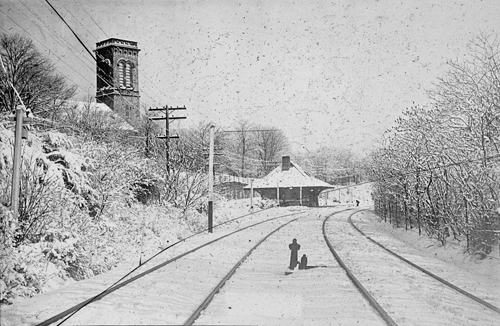 |
Brookline Village Train Station, 1874
This is the oldest known photograph of the full train station in the Village. Visible are the signs for the post office and the telegraph, both of which were housed in the depot. Visible in the rear is a train parked on a side track.
[Source: Brookline Public Library]
|
 |
Boston and Albany Rail Station, Brookline Village
Looking east. The partially-visible building behind the station at 31 and 34 Station Street still stands.
|
 |
Brookline Village Train Station, circa 1885
At Station St., looking west under the Washington St. bridge. Only entrance to White Place.
Tom Condon, Sr. Civil Engineer for Brookline writes:
It would be interesting to note that the roadway passing under the bridge to the right of the railroad was the only access to White Place at the time since it was a dead end street. When the bridge was later widened, it was also shortened so as to only cross the railroad tracks. The end of White Place was filled in to meet the grade of the new bridge. That is the reason for the retaining wall between White Place and the "D" line which is located about where the center support of the bridge is.
|
 |
Railroad Station, Brookline Village
Heading east, current location of Brookline Village "D" Line stop of the MBTA. Station St. to the left
|
 |
Washington St. at School St.
Standing on Washington St. looking north at the Bethany Building. School St. is to the right. The steeple is in the first of three iterations, it was reduced in size over time. Known as the “Bethany Building”, the church was constructed in 1844 as the first church in Brookline of the newly-organized Harvard Congregational Society. The building was sold in 1873 as the Society prepared to move to a larger structure at the corner of Harvard St. and Marion St. After a brief stint as a Methodist church followed by several additional changes of ownership, the building was acquired in 1887 by the Bethany Sunday School Association which held it for the next twenty years. The building was torn down in 1928.
The horse-drawn car is being pulled on rails which were first laid in 1859 and has reached its final stop at Washington and School streets. At these final stops the horse(s) would be unhitched and attached to the other end of the car and the route retraced. This car #7 is also seen in another Village photo, that one dated 1873.
[Source: Digital Commonwealth]
|
 |
Trolley on Washington St.
Looking north toward Beacon St, passing Park Ave. on the right Right to left: #465 and #471, apartment buildings still stand. Summit Ave. hill visible in the background
[Source: Joel Shield]
|
 |
Chapel Station, Carlton & Colchester St.
Flag station for the Boston and Albany Railroad and pedestrian crossing; the southern end of Carlton St. is on the left; note same man as in the Longwood Station photo and the other man at the left hand corner of the building
|
 |
Longwood Flag Station, Boston and Albany Railroad
By the Longwood Ave overpass, looking east; Sears Chapel in the background; note same man as in the Chapel Station photo
|
 |
Longwood Station, Boston and Albany Railroad
[Source: Iowa State]
|
 |
Sear's Chapel, Longwood Station, Muddy River
|
 |
Longwood Ave. Trolley, 1891
This rare photo shows the trolley traveling westward having just passed St. Paul St. on its way to Coolidge Corner. It is approaching the house of Charles Dudley at 60 Longwood Ave. Dudley, who had recently purchased the property, would soon move his house to the west and sell the expanded corner property, vacant in the photo, to Jacob Bates who constructed his house there.
This trolley line would soon be eliminated and the tracks, which only ran on the north side of Longwood Ave., removed.
[Source: Leo Sullivan]
|
 |
Boylston St. Trolley, 1910
Traveling inbound in the area of Chestnut Hill Ave.
|
 |
Boylston St. at Hammond St.
Boylston St. looking west from Hammond St. Louis Henry Graves opened his drug store at 1186 Boylston St. circa 1907 after working at the Young and Brown drug store in Coolidge Corner. He sold the business circa 1924.
|
 |
Boylston St. at Hammond St.
[Source: Brookline Preservation Department]
|
 |
Trolley Car, Brookline Village
Washington St. heading toward Rt. 9 and Boston. This is a Type Four car, in use in Boston from 1911-1950. The two brick buildings still stand. While nominally just a photo of a subway car this photo actually contains a number of interesting details of Village life in the late 1930s. To the right is the front end of what appears to be a 1935 Chevrolet Master Deluxe Coupe. And there are glimpses of the following businesses:
- Earl Colvin, dentist, is the clearest. He was at that location (221 Washington Street) as early as 1922 and as late as 1940. In 1944 he had moved to 1 Harvard Street.
- Moore's, up the street, is Moore's Grille at 6-9 Harvard Square.
- A.J. Grennan, Chiropodist.
- Wolf & Smith, Meats. They are beneath Colvin and the name is only partly visible. They were there as early as the 1920s through at least 1944.
- Elisabeth Cleansing Shop. The name is on the corner above the back of the trolley.
- Daniel Goldberg. His name is on the window next to Grennan, but we don't find him in the city directories.
|
 |
Trolley Barn, Boston Elevated Railway Co.
Corner Cypress and Franklin, demolished 1934. The trolleys ran along Boylston to Cypress
[Source: Joel Shield]
|